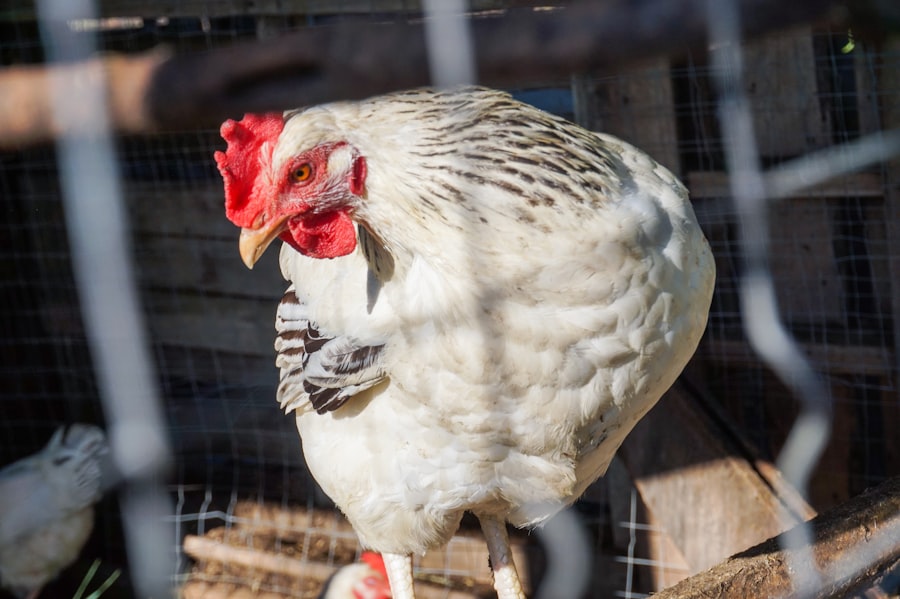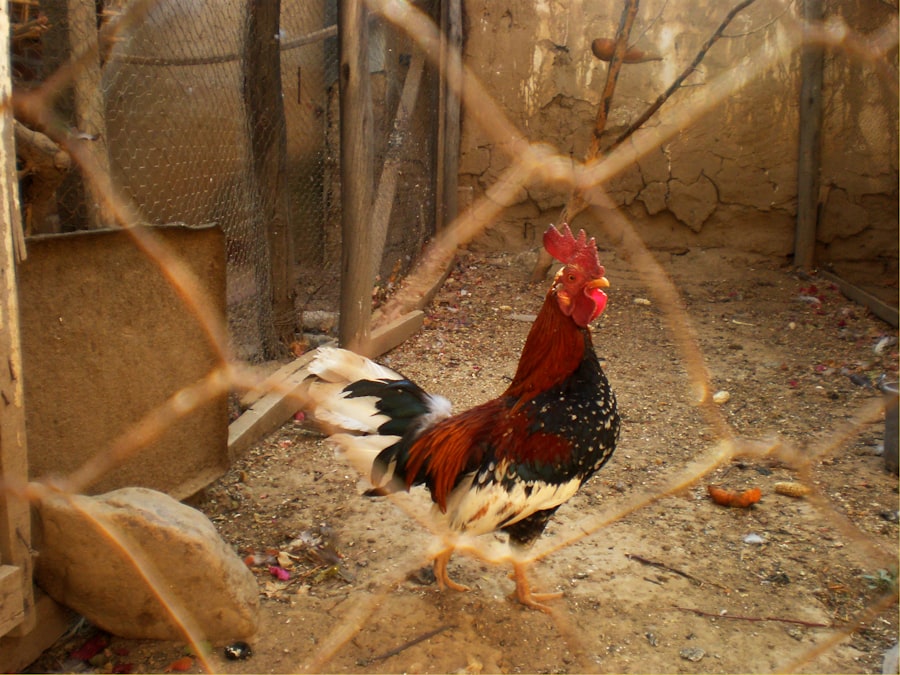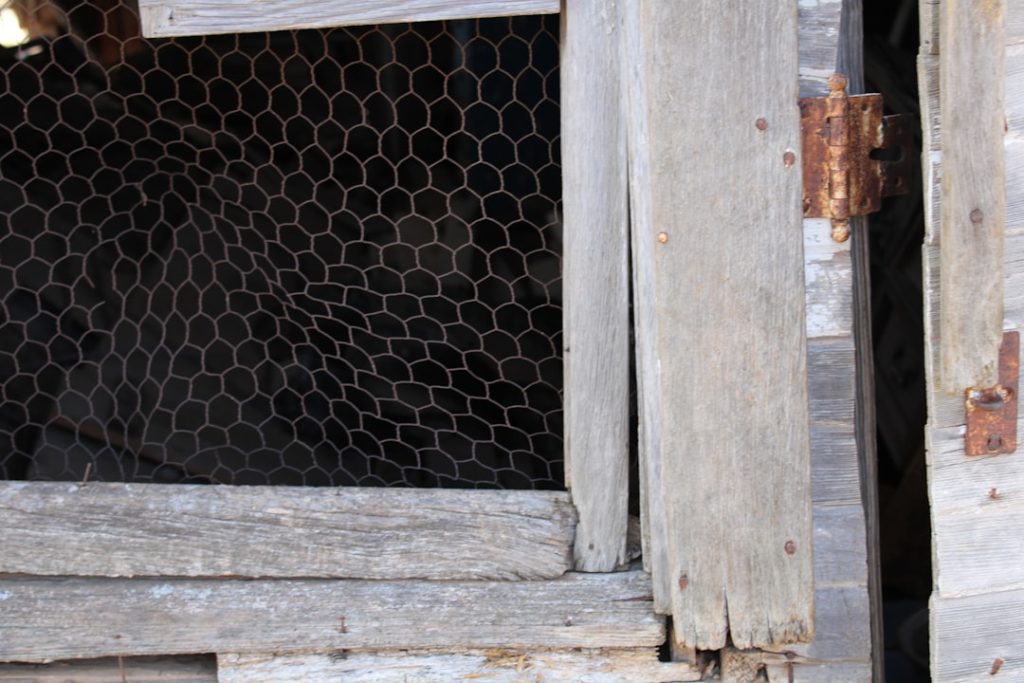Tall fences are essential for chicken safety and security. They serve as effective barriers against predators such as foxes, raccoons, and dogs, while also preventing chickens from escaping. A sturdy, high fence provides chickens with a secure environment to roam and forage without fear of attack.
It also establishes clear boundaries, reducing potential conflicts with neighboring properties or animals. In addition to protection from external threats, tall fences help contain chickens within safe areas. This prevents them from wandering into dangerous locations like roads or properties with aggressive animals.
Containment within a designated space reduces the risk of accidents and provides peace of mind for poultry owners. Tall fences also offer protection against human interference, including trespassing and theft. The importance of tall fences in chicken keeping cannot be overstated.
They provide physical protection, create a sense of security for the flock, and ensure the overall well-being of the chickens. For these reasons, a tall and sturdy fence is a crucial investment for any poultry owner committed to maintaining a safe and secure environment for their birds.
Table of Contents
- 1 Factors to Consider When Determining the Height of Your Chicken Fence
- 2 Recommended Heights for Chicken Fences Based on Breed and Predation Risk
- 3 Tips for Installing and Maintaining a Tall Fence for Your Chickens
- 4 Potential Consequences of Choosing an Inadequate Fence Height for Your Chickens
- 5 Alternatives to Traditional Fencing for Keeping Chickens Safe and Secure
- 6 Finding the Right Balance of Height and Security for Your Chicken Fence
- 7 FAQs
- 7.1 What height should a fence be to keep chickens in?
- 7.2 Why is a 6-foot fence recommended for keeping chickens in?
- 7.3 Are there any other factors to consider when choosing a fence height for chickens?
- 7.4 What are some other options for keeping chickens contained if a 6-foot fence is not feasible?
Key Takeaways
- A tall fence is crucial for keeping chickens safe from predators and preventing them from escaping.
- Factors to consider when determining fence height include the breed of chickens, the level of predation risk, and the terrain of the area.
- Recommended fence heights vary based on the breed of chickens and the potential predation risk in the area.
- Tips for installing and maintaining a tall fence include using sturdy materials, regularly inspecting for damage, and securing the bottom to prevent digging predators.
- Choosing an inadequate fence height can result in chickens escaping, being attacked by predators, or experiencing stress and reduced egg production.
- Alternatives to traditional fencing for keeping chickens safe and secure include electric fencing, chicken wire, and using natural barriers like hedges or bushes.
- Finding the right balance of height and security for your chicken fence is essential for keeping your chickens safe and happy while minimizing the risk of predation.
Factors to Consider When Determining the Height of Your Chicken Fence
Assessing Potential Threats
Firstly, you need to assess the potential threats in your area, such as the types of predators that may target your chickens. This will help you determine the minimum height required to deter these predators from accessing your flock.
Considering Chicken Breed and Property Layout
Additionally, consider the size and breed of your chickens, as larger breeds may require a taller fence to prevent them from flying over or escaping. Another important factor to consider is the terrain and layout of your property, as uneven ground or obstacles may require adjustments in fence height to maintain its effectiveness. Furthermore, take into account any local regulations or restrictions regarding fence height to ensure compliance with legal requirements.
Factoring in Purpose and Future Expansion
Moreover, consider the purpose of your chicken fence, whether it is solely for containment or also for providing a secure outdoor space for your chickens to roam and forage. This will influence the height needed to accommodate their natural behaviors while ensuring their safety. Additionally, factor in any potential future expansion of your flock, as this may require adjustments in fence height to accommodate the increased number of chickens.
Material and Construction Considerations
Lastly, consider the materials and construction of the fence, as certain types of fencing may have limitations in height or require additional support for taller structures. By carefully considering these factors, you can determine the appropriate height for your chicken fence to effectively protect your flock from potential threats and provide them with a secure environment.
Recommended Heights for Chicken Fences Based on Breed and Predation Risk

The recommended height for chicken fences varies based on the breed of chickens and the level of predation risk in your area. For standard-sized breeds such as Rhode Island Reds or Plymouth Rocks, a fence height of at least 6 feet is generally recommended to prevent them from flying over and escaping. Bantam breeds, on the other hand, may require a slightly lower fence height of around 4-5 feet due to their smaller size and reduced ability to fly long distances.
Additionally, consider the presence of potential predators in your area when determining fence height. For areas with high predation risk from larger predators such as foxes or coyotes, a taller fence of 6-8 feet may be necessary to effectively deter these threats. On the other hand, areas with lower predation risk from smaller predators may require a fence height of 4-6 feet to provide adequate protection for the chickens.
Furthermore, consider the potential for aerial predators such as hawks or owls when determining fence height. In areas with high risk of aerial attacks, additional measures such as netting or overhead coverage may be necessary to protect the chickens from these threats. Additionally, take into account the natural behaviors of your chickens, such as their ability to fly or perch, when determining fence height.
For breeds with strong flying abilities or tendencies to roost at higher elevations, taller fences or additional measures to prevent flying may be necessary to keep them contained and safe. By considering these factors and assessing the specific needs of your flock and the level of predation risk in your area, you can determine the recommended height for your chicken fence to provide effective protection and security for your chickens.
Tips for Installing and Maintaining a Tall Fence for Your Chickens
When installing a tall fence for your chickens, there are several tips to keep in mind to ensure its effectiveness in providing security and protection for your flock. Firstly, choose durable and sturdy materials for your fence that can withstand external threats and provide long-term security for your chickens. Consider options such as welded wire fencing or chain-link fencing that offer strength and durability against potential predators.
Additionally, ensure that the fence is securely anchored into the ground to prevent digging predators from gaining access underneath it. Use buried wire mesh or concrete footings to reinforce the base of the fence and prevent any potential weak points. Furthermore, regularly inspect and maintain your chicken fence to address any signs of wear or damage that may compromise its effectiveness in keeping your flock safe.
Replace any damaged or weakened sections of the fence promptly to prevent potential breaches by predators. Additionally, consider adding deterrents such as electric fencing or predator-proofing measures to further enhance the security of your chicken enclosure. These additional measures can provide an extra layer of protection against determined predators and help to maintain a secure environment for your chickens.
Lastly, consider incorporating features such as predator-proof latches and locks on gates to prevent unauthorized access and ensure that your chickens remain safe within their enclosure. By following these tips for installing and maintaining a tall fence for your chickens, you can provide a secure and protected environment for your flock while minimizing potential risks from predators.
Potential Consequences of Choosing an Inadequate Fence Height for Your Chickens
Choosing an inadequate fence height for your chickens can have significant consequences that compromise their safety and security. A fence that is too low may allow predators such as foxes or raccoons to easily jump over or climb through it, putting your flock at risk of attacks and potential harm. Additionally, inadequate fence height can lead to escapes by your chickens, resulting in lost birds and potential conflicts with neighboring properties or animals.
Furthermore, choosing an inadequate fence height may lead to increased stress and anxiety for your chickens, as they feel vulnerable and exposed to potential threats without adequate protection. Moreover, inadequate fence height can result in increased maintenance and repair costs as you may need to address frequent breaches by predators or escapes by your flock. This can be both financially burdensome and time-consuming, requiring constant vigilance and adjustments to maintain the security of your chicken enclosure.
Additionally, inadequate fence height can lead to conflicts with local regulations or restrictions regarding poultry containment, potentially resulting in legal consequences or fines. Overall, choosing an inadequate fence height for your chickens can have far-reaching consequences that compromise their safety, well-being, and overall security within their environment.
Alternatives to Traditional Fencing for Keeping Chickens Safe and Secure

Electric Fencing: A Deterrent Against Predators
One option is using electric fencing as a deterrent against predators, providing an effective barrier without the need for excessive height. Electric fencing delivers a mild shock to potential predators that come into contact with it, effectively deterring them from attempting to breach the enclosure.
Overhead Protection and Natural Barriers
Additionally, consider using poultry netting or mesh covers over outdoor areas to provide overhead protection against aerial predators such as hawks or owls. These alternatives can offer effective protection for your flock without relying solely on traditional fencing methods. Furthermore, consider utilizing natural barriers such as hedges or dense vegetation to create a protective boundary around your chicken enclosure. These natural barriers can act as a deterrent against potential predators while providing additional environmental enrichment for your flock.
Mobile Coops and Predator-Proofing Measures
Additionally, consider using mobile chicken coops or tractors that can be moved around your property to provide fresh grazing areas while maintaining security for your chickens. These alternatives offer flexibility in managing your flock while ensuring their safety within a secure environment. Lastly, consider incorporating predator-proofing measures such as secure latches on coop doors and windows to prevent unauthorized access by potential threats. By exploring these alternative methods for keeping chickens safe and secure, you can find effective solutions that meet the specific needs of your flock while minimizing potential risks from predators.
Finding the Right Balance of Height and Security for Your Chicken Fence
In conclusion, finding the right balance of height and security for your chicken fence is essential in providing a safe and secure environment for your flock. A tall fence serves as a crucial barrier against potential predators while also containing your chickens within designated areas, preventing escapes and potential conflicts with neighboring properties or animals. When determining the height of your chicken fence, consider factors such as breed size, predation risk, natural behaviors, and property layout to ensure its effectiveness in providing protection for your flock.
Additionally, explore alternative methods such as electric fencing, natural barriers, and mobile coops to find solutions that meet the specific needs of your flock while maintaining their safety and security. By following tips for installing and maintaining a tall fence and considering recommended heights based on breed and predation risk, you can create a secure environment that minimizes potential risks for your chickens. Ultimately, finding the right balance of height and security for your chicken fence is crucial in providing peace of mind for poultry owners while ensuring the safety and well-being of their flock within their environment.
If you’re considering building a garden chicken coop, you may also want to think about how tall your fence needs to be to keep your chickens in. According to a helpful article on Poultry Wizard, the size and height of your fence can play a crucial role in keeping your chickens safe and secure. To learn more about building the perfect coop for your chickens, check out this article.
FAQs
What height should a fence be to keep chickens in?
The recommended height for a fence to keep chickens in is at least 6 feet tall. This will prevent most chicken breeds from flying over the fence.
Why is a 6-foot fence recommended for keeping chickens in?
A 6-foot fence is recommended to prevent most chicken breeds from flying over the fence. Chickens are capable of flying short distances, and a 6-foot fence height is generally sufficient to keep them contained.
Are there any other factors to consider when choosing a fence height for chickens?
In addition to the height of the fence, it’s important to consider the breed of chickens being kept and their ability to fly. Some breeds are better flyers than others, so it’s important to assess the specific needs of the flock when choosing a fence height.
What are some other options for keeping chickens contained if a 6-foot fence is not feasible?
If a 6-foot fence is not feasible, other options for keeping chickens contained include using netting or wire covers over the chicken yard to prevent them from flying out. Additionally, trimming the feathers of one wing (a process known as “wing clipping”) can also prevent chickens from flying over fences.
Meet Walter, the feathered-friend fanatic of Florida! Nestled in the sunshine state, Walter struts through life with his feathered companions, clucking his way to happiness. With a coop that’s fancier than a five-star hotel, he’s the Don Juan of the chicken world. When he’s not teaching his hens to do the cha-cha, you’ll find him in a heated debate with his prized rooster, Sir Clucks-a-Lot. Walter’s poultry passion is no yolk; he’s the sunny-side-up guy you never knew you needed in your flock of friends!







